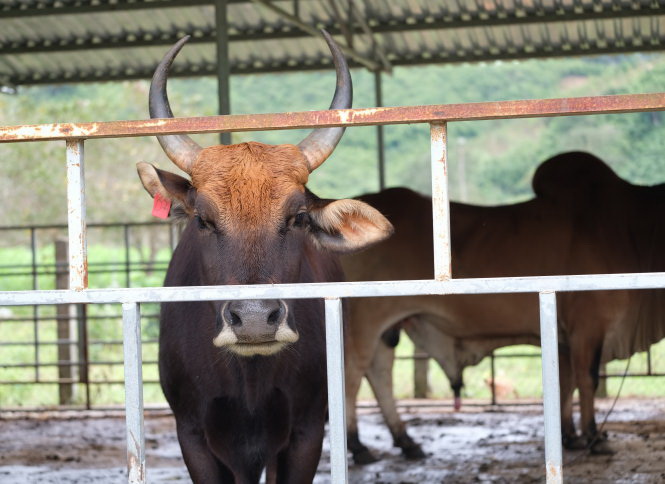Vietnamese researchers have been working to breed more hybrid gayals in order to conserve the gene pool and produce animals with a higher-grade meat.
A team of researchers have tried to preserve the gene pool of the rare ox, predominantly found in wooded areas bordering the south-central provinces of Ninh Thuan and Khanh Hoa as well as Lam Dong Province in the Central Highlands, and they have achieved encouraging results over the past few years.
Acknowledged as the ‘wild ox’ with the largest body in the world, the gayal, with the scientific name Bos gaurus, has been pushed to the verge of extinction in Vietnam over recent years.
Thankfully, more than 20 hybrid gayals have been born since 2011 in villages surrounding Phuoc Binh National Park in Bac Ai District in Ninh Thuan Province, after a wild gayal bull started mating with domesticated cows while roaming the park during 2009.
The one-ton gayal, which died of old age in 2015, would spend four to six months in the park during each of his visits to the province, where he grazed in the corn fields and mated with dozens of farm cows at the edge of the forest, with no other ox daring to challenge his dominance.
The offspring the wild gayal bull left behind – the first generation of hybrid gayals – are on average three times bigger than any farm cow and weigh between 500 and 600kg by the time they reach age three.
The hybrids display the behavioral and physical traits of their wild gayal father, including dark fur on their backs and bodies, white fur from the knees down, no humps on their back, an aggressive attitude, and long, curved horns.
According to Associate Professor Le Xuan Tham, former director of the Lam Dong Department of Science and Technology and a member of the research team, the wild gayal, second only to the tiger in regard to their aggressiveness, tends to charge at hunters upon hearing the sound of gunshots.
With the gayal’s wild characteristics in their blood, the hybrids are far more active and aggressive than regular farm cows.
Tham and his team set up the research farm where the intimidating wild gayal first appeared in 2009.
The hybrid quadrupeds are constantly roaring at the farm as they continuously rumble after one another, knocking over barbed wire fences.
“These half-blood animals are even more playful and destructive than their wild father. No fence can survive,” Ho Ba Quan, from the Lam Dong Department of Science and Technology, said.
Tasked with tending to and recording the herd’s development, Quan admitted to feeling intimidated every time he approaches them to take blood samples.
He usually approaches the bovine herd with great caution and only once they have a full stomach and lying idle.
“They may look meek but can attack quickly if they are handled roughly,” Quan explained.

Hybrid gayal bulls, which are genetically aggressive, should be approached with great caution. Photo: Tuoi Tre.
Though gayals have been seen roaming some localities in the central provinces, including Cat Tien National Park, no case of ‘cohabitation’ between wild gayals and domesticated cattle has been recorded.
Tran Que, from the Da Lat Nuclear Research Institute’s Biotechnology Center in Da Lat City, Lam Dong, said his research team could only keep 10 first-generation hybrid calves, as the farmers had sold the remainder before the team offered to buy them.
Assoc. Prof. Tham stressed that the hybrids had displayed dominant characteristics including their larger size, better resistance to disease and superior adaptability to the hot climate.
His team is set on expanding the hybrid herd in an effort to create a new gene pool for the local animal husbandry industry.
The one-of-a-kind match between the wild beasts and tamed cows has also resulted in higher-grade of meat and increased meat production.
“Breeding the next generation of gayal hybrids will tap the wild gayals’ prized gene pool, and create new gene combinations and premium meat-producing strains,” he elaborated.
“What we are doing is imitating what prehistoric people did. They would take home different bovine breeds following hunting trips and let them loose in sheds so that they could freely mate, resulting in random crossbreeds,” he added.
Tham revealed his team is working hard to ‘match-make’ first-generation bull and heifer hybrids with cattle in both a controlled and random mode.
In early 2016, the research farm welcomed hybrids of the second and third generations, all of which are heifers.
First-generation hybrid bulls have mated with farm cows but have so far failed to successfully impregnate their mates.
Que, from the Da Lat Nuclear Research Institute’s Biotechnology Center, underlined that though the third-generation heifers’ chromosomes have yet to be decoded, they are confirmed as gayal hybrids based on the gayal-like traits they have inherited from their mother, particularly the horns and white leg markings.
“We’ve successfully bred the deceased gayal’s traits, but there remains a lot of work if the meat-producing herd are to be expanded and improved, as we really need potent first-generation hybrid bulls,” Tham explained.
Copulation between first-generation hybrid bulls and farm cows can easily result in dozens or even hundreds of new hybrids.
“It’s difficult to enlarge the herd from first-generation [female] heifers which only give birth to one calf each year, while first-generation bulls will die in 20 years,” Tham noted.
The research team later divulged the good news: one domesticated heifer kept by a farmer has reportedly conceived after mating with a first-generation hybrid bull.
Another cow kept at the research farm has also been confirmed pregnant, with the farm’s records indicating that the fetus belongs to a first-generation hybrid bull.
“After the heifer gives birth, we’ll decode the calf’s chromosomes to see if a rare occurrence has happened in Phuoc Binh,” Tham said hopefully.
Like us on Facebook or follow us on Twitter to get the latest news about Vietnam!


















































